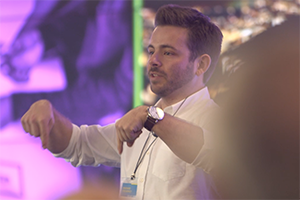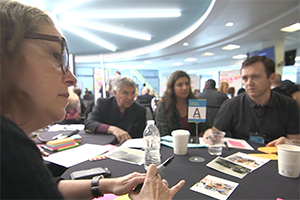Often times, California’s size and diversity are viewed as a challenge by those charged with providing quality public services. But for the state and county officials who gathered for the first-ever mental health innovation summit, diversity provided a creative advantage.
For starters, what might have otherwise been a typical gathering of mental health care providers, consumers and stakeholders was infused with leaders and thinkers from the world of technology – bringing new tools and new thinking to the longstanding problem of how to improve access and services for people with mental health needs.
“Innovate for Impact: Improving Access to High Quality Mental Health Care,” which was organized by the state California Mental Health Services Oversight and Accountability Commission and multiple partners, drew 300 people for a one-day summit and workshop at Verily Life Sciences in South San Francisco earlier this year.
Proposition 63, the Mental Health Services Act, created the Commission and charged it with improving the mental health system. The law also provides significant funding to counties, including a dedicated fund for exploring new or adaptive approaches in community mental health, including the use of technology.
“California has this unique advantage rooted in Proposition 63,” said John Boyd, chair of the state Commission and CEO of Sutter Health’s Mental Health Services. “Approximately $100 million a year gets approved and distributed throughout the counties with the sole focus of doing mental health in a way that’s different, in a way that’s human-centered and human-designed and really meets the needs of the community and the individual.”
The need for tailored services is reinforced by the need for tailored systems. With California’s 58 counties ranging from populations of more than 10 million (Los Angeles) to just more than 1,000 (Alpine), one-size solutions won’t fit everyone.
Mono County with 14,000 people has fewer people yet an expansive geography.
“Lots of people come to Mono County to be isolated and not be around people, so the challenges of creating access for people who don’t really want to be around people is something that we’re talking about quite a bit,” said Mono County Director of Behavioral Health Robin Roberts.
Conversely, Los Angeles County with a population larger than 41 states poses a different set of problems, said Dr. John Sherin, director of behavioral health for Los Angeles County.
“If we are successful in moving upstream and doing more prevention work, we will have less people on the streets and going into jails,” he said. “The streets, the jails and the hospitals are toxic environments. We have to figure out ways to keep people from falling into that vortex.”
 The solution to that challenge – as well as the technology – may change from region to region.
The solution to that challenge – as well as the technology – may change from region to region.
“Tribal communities – we’re not technologically advanced,” said Tristin Severns, a youth advocate at the Humboldt County Transition-Age Youth Collaboration. “A lot of places – you wouldn’t believe – have no Wi-Fi. A lot of people don’t even know what a cell phone is or text message.”
One objective of the session was to define the potential for an “innovation hub” that will allow private and public sector professionals to work together to develop solutions that are adapted to diverse conditions. Governor Brown in his 2017-18 budget proposed $5 million to start up an ongoing effort to help counties to develop and replicate innovative service strategies.
 Andrew Evans, a design lead from IDEO and the summit facilitator, said different voices are helpful to creating innovative solutions. “You’ve got a table with a mental health consumer, alongside a provider, alongside an elected official, alongside a behavioral health director of a county. You have all of those unique perspectives that are now helping to create an idea that might create a new mode of access for mental health.”
Andrew Evans, a design lead from IDEO and the summit facilitator, said different voices are helpful to creating innovative solutions. “You’ve got a table with a mental health consumer, alongside a provider, alongside an elected official, alongside a behavioral health director of a county. You have all of those unique perspectives that are now helping to create an idea that might create a new mode of access for mental health.”
In Mono County it can take hours to reach a consumer, so Roberts and her team created new ways to provide services.
“When you live in a place where circumstance dictates what you can and cannot do, you become innovative in that system,” she said. “If we’re going to hospitalize someone and we can find a bed for them, that’s a seven hour drive, one way. So we’ve become very good at wrapping services around people who are in a crisis.”
L.A. County’s Sherin said the innovation funding is a rare opportunity to transform community public health systems: “The end of the day, if we’re effective in our use of innovation funding and innovation thinking, we will be moving our interventions upstream and preventing the development of serious, refractory, persistent mental illness in a significant part of the population that is currently suffering.”
Los Angeles and Kern counties have partnered with the mental health commission to leverage what they call the “mental health technology suite.” It has three basic components: 1) detecting distress in real time using technology; 2) connecting individuals with resources in real time using chat; and 3) virtual, avatar-based treatment paradigms that have traditionally been done face-to-face.
 “These three initiatives have a dramatic impact on access for folks – because they’re not benefitting from the current system or they can’t navigate the system, or they’re frankly unwilling to engage the current system,” Sherin said.
“These three initiatives have a dramatic impact on access for folks – because they’re not benefitting from the current system or they can’t navigate the system, or they’re frankly unwilling to engage the current system,” Sherin said.
From a very different environment, Severns, the youth advocate from Humboldt, sees access to technology as a big step forward for tribal communities.
“On reservations, set up more Wi-Fi, provide more cell phone services, be able to provide more things like that. Not only is it a problem for suicide hotlines, but ambulances, first responders, you have to drive hours to get to a phone.”
These innovations could be a big step toward better services and access, according to Commission Vice Chair Khatera Aslami-Tamplen. “What I’ve heard is that if we can improve access, then technology can help link us to the support services. We know that technology in the healthcare system is helping link doctors or psychiatrists to patients much quicker.”
The Commission in 2018 plans to work with leaders like those at the summit to develop an ongoing collaborative effort that will encourage the development and replication of innovative tools and practices that tailor services to the needs of individuals and the circumstances of California’s diverse regions.
Read our entire series on innovation in mental health services
Part 1: Tech Industry and Mental Health Advocates Seek Solutions at First-Ever Summit
Part 2: County and Tech Innovators Are Rethinking California’s Mental Health Services
Part 3: Can California’s Techies Move the Needle on Mental Health?

